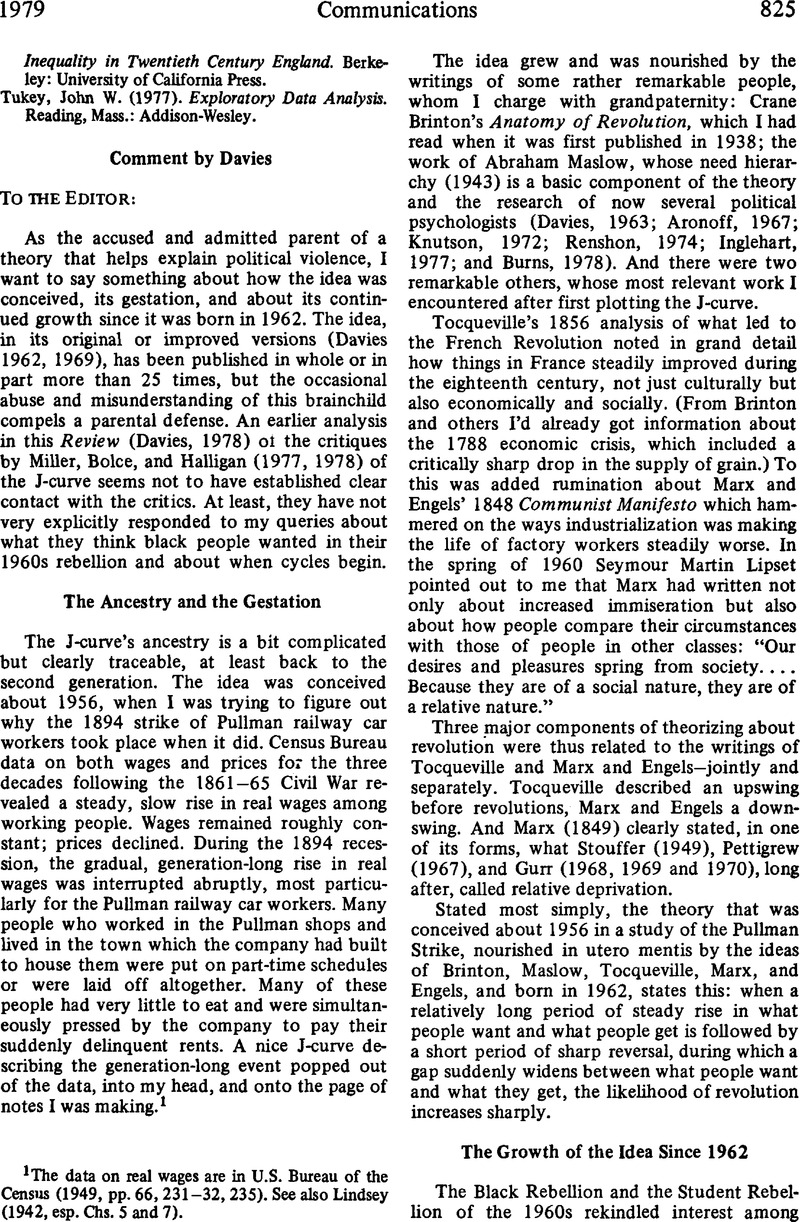No CrossRef data available.
Article contents
Comment by Davies
Published online by Cambridge University Press: 01 August 2014
Abstract
An abstract is not available for this content so a preview has been provided. Please use the Get access link above for information on how to access this content.

- Type
- Communications
- Information
- Copyright
- Copyright © American Political Science Association 1979
References
Aronoff, Joel (1967). Psychological Needs and Cultural Systems. New York: Van Nostrand Reinhold.Google Scholar
Brinton, Crane (1965; first published 1938). The Anatomy of Revolution. New York: Vintage, Random House.Google Scholar
Davies, James C. (1962). “Toward a Theory of Revolution.” American Sociological Review 61:5–19.CrossRefGoogle Scholar
Davies, James C.. (1963). Human Nature in Politics. New York: Wiley, esp. Chs. 1 and 2.Google Scholar
Davies, James C. (1969). “The J-Curve of Rising and Declining Satisfactions as a Cause of Some Great Revolutions and a Contained Rebellion.” In Graham, H. D. and Gurr, T. R. (eds.), The History of Violence in America. New York: Bantam edition, pp. 690–730.Google Scholar
Davies, James C. (1974). “The J-Curve and Power-Struggle Theories of Collective Violence.” American Sociological Review 39: 607–10.CrossRefGoogle Scholar
Davies, James C. (1977a). “The Priority of Human Needs and the Stages of Political Development.” In Pennock, J. Roland and Chapman, J. W. (eds.), Human Nature in Politics. New York: New York University Press, pp. 157–96.Google Scholar
Davies, James C. (1977b). “The Development of Individuals and the Development of Polities.” In Ritzgerald, Ross (eds.), Human Needs and Politics. Rushcutters Bay, New South Wales: Pergamon, pp. 74–95.Google Scholar
Davies, James C. (1978). “The J-Curve Theory.” American Political Science Review 72:1357–58.CrossRefGoogle Scholar
Edwards, Lyford P. (1927). The Natural History of Revolution. Chicago: University of Chicago Press.Google Scholar
Gurr, Ted Robert (1968). “A Causal Model of Civil Strife.” American Political Science Review 62:1104–24.CrossRefGoogle Scholar
Gurr, Ted Robert (1969). “A Comparative Study of Civil Strife.” In Graham, H. D. and Gurr, T. R. (eds.), The History of Violence in America, New York, Bantam edition, pp. 572–632.Google Scholar
Inglehart, Ronald (1977). The Silent Revolution. Princeton, N.J.: Princeton University Press.Google Scholar
James, William (1950; first published 1890). “Instinct.” In The Principles of Psychology. New York: Dover, Ch. 24.Google Scholar
Marx, Karl, and Engels, F. (1968; first published 1848). The Communist Manifesto. New York: International Publishers.Google Scholar
Marx, Karl (1955; first published 1849). “Wage Labour and Capital.” In Selected Works in Two Volumes. Moscow: Foreign Languages, Vol. 1, p. 94.Google Scholar
Maslow, Abraham (1943). “A Theory of Human Motivation.” Psychological Review 50: 370–96.CrossRefGoogle Scholar
McDougall, William (1908). An Introduction to Social Psychology. Boston: Luce, Chs. 2–4.CrossRefGoogle Scholar
Miller, Abraham H., Bolce, Louis H., and Halligan, Mark (1977). “The J-Curve Theory and the Black Urban Riots: An Empirical Test of Progressive Relative Deprivation Theory.” American Political Science Review 71: 964–82.CrossRefGoogle Scholar
Miller, Abraham H., Bolce, Louis H., and Halligan, Mark (1978). “Communication.” American Political Science Review 72:1358–60.CrossRefGoogle Scholar
Murray, Henry Alexander (1938). Explorations in Personality. New York: Oxford University Press, pp. 77–83.Google Scholar
Olson, Mancur Jr., (1963). “Rapid Growth as a Destabilizing Force.” Journal of Economic History 23:529–52.CrossRefGoogle Scholar
Pettigrew, Thomas F. (1967). “Social Evaluation Theory: Consequences and Applications.” In Levine, David (ed.), Nebraska Symposium on Motivation. Lincoln: University of Nebraska Press, pp. 241–315.Google Scholar
Renshon, Stanley Allen (1974). Psychological Needs and Political Behavior. New York: Free Press.Google Scholar
Snyder, David, and Tilly, Charles (1972). “Hardship and Collective Violence in France, 1830–1960.” American Sociological Review 37:520–32. (Note the discussion of this article in Davies [1974] and Snyder and Tilly [1974]).CrossRefGoogle Scholar
Snyder, David, and Tilly, Charles (1974). “On Debating and Falsifying Theories of Collective Violence.” American Sociological Review 39: 610–13.CrossRefGoogle Scholar
Stouffer, Samuel A., et al. (1949). The American Soldier. Princeton, N.J.: Princeton University Press.Google Scholar
Tilly, Charles (1978). From Mobilization to Revolution. Reading, Mass.: Addison-Wesley.Google Scholar
Tocqueville, Alexis de (1955; first published 1856). The Old Regime and the French Revolution. New York: Anchor, Doubleday.Google Scholar
U.S. Bureau of the Census (1949). Historical Statistics of the United States: 1789–1945. Washington, D.C.: Government Printing Office.Google Scholar



Comments
No Comments have been published for this article.